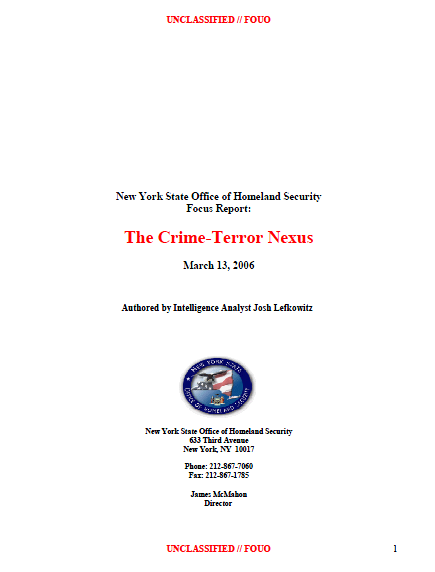New York State Office of Homeland Security Focus Report: The Crime-Terror Nexus
- 11 pages
- For Official Use Only
- March 13, 2006
On May 18, 2005, Stuart Levey, the U.S. Treasury Department’s Under Secretary for Terrorism and Financial Crimes, announced that the U.S. intelligence community had “indications that terrorist groups like Al Qaeda and Hamas are feeling the pressure and are hurting for money.” A week later, an FBI Intelligence Bulletin echoed Levey’s conclusion and noted that “multinational efforts have helped to disrupt Al Qaeda’s financial network.” The U.S. government’s release of Ayman Zawahiri’s July 9, 2005 letter to Al Qaeda in Iraq leader Abu Musab al-Zarqawi, in which Zawahiri requested “a new payment…of approximately one hundred thousand” “while new lines are being opened,” provided further evidence supporting the Treasury Department’s evaluation.
As authorities have clamped down on traditional financing pipelines, such as charitable front groups, and as terrorist networks have grown increasingly decentralized, terrorists have turned to criminal activities to finance their operations locally. Throughout the world, Al Qaeda, Hamas, and Hezbollah operatives have involved themselves in an array of criminal enterprises, including counterfeiting, drug dealing, cigarette smuggling, credit card fraud, auto theft, kidnapping, extortion, and artifact trafficking. Although criminality is outlawed under Islamic law, the Al Qaeda manual advises that “necessity permits the forbidden.” Reflecting this theory, when Jemaah Islamiyah (JI) operatives questioned whether hacking into foreigners’ bank accounts was acceptable in Islam, JI leader Abu Bakr Bashir reportedly responded, “[if] you can take their blood; then why not take their property?”
“Terrorist groups are particularly interested in raising funds through crime because as Lieutenant Colonel David LaRivee, Associate Professor of Economics at the United States Air Force Academy, stated, “many of the agencies responsible for enforcement in these areas do not traditionally focus on counterterrorism nor do they have strong ties with counterterrorist agencies. This means that many indictable criminal activities that support terrorism are overlooked because they seem insignificant when evaluated locally, but are in fact very significant when considered from a broader perspective.” In order to disrupt these financing efforts, “local law enforcement officials will be key,” as the FBI assessed in a May 25, 2005 Intelligence Bulletin.
…
There is a particularly strong nexus between Afghan heroin trafficking and Islamic extremist groups. In 2002, Asa Hutchinson commented that “the DEA has…received multisource information that Osama bin Laden himself has been involved in the financing and facilitation of heroin-trafficking activities.” Further highlighting the nexus, the U.S. government extradited Baz Mohammad from Afghanistan in October 2005. According to the DEA, Mohammad’s organization imported tens of millions of dollars of heroin into the United States and “provided financial support to the Taliban…In exchange for its financial support, the Taliban provided the Baz Mohammad Organization protection for its opium crops, heroin laboratories, drug-transportation routes, and members and associates.” Mohammad allegedly believed “that selling heroin in the United States was a ‘jihad’ because they were taking the Americans’ money at the same time the heroin they were paying for was killing them.” A U.S. official, commenting in the media, noted that Osama bin Laden shares Baz Mohammad’s philosophy: “Bin Laden does not mind trafficking in drugs, even though it’s against the teaching of Islam, because it’s being used to kill Westerners.”
…
Within the United States, Hezbollah is the terrorist group most actively involved in narcotics trafficking. In January 2002, the DEA announced the arrest of more than 100 people involved in an expansive methamphetamine network. The investigation resulted in the arrest of individuals in twelve cities across the United States and Canada, along with the seizure of more than 179 pounds of finished methamphetamine, six clandestine drug laboratories, and $4.5 million in U.S. currency. Authorities were able to track $10 million back to the Middle East, and then-DEA head Asa Hutchinson asserted that at least some of that money financed Hezbollah. In another case, Ohio resident Mohammad Shabib sent money to Hezbollah raised through a drug dealing operation in which he sold tons of pseudoephedrine to Mexican gangs for use in methamphetamine production. Additionally, individuals operating in Latin America, particularly in the Tri-Border region of Argentina, Brazil, and Paraguay, reportedly traffic drugs to support Hezbollah operations in Lebanon.
…
Cooperation on cross border human trafficking, an estimated $10 billion a year industry, is particularly worrisome and was confirmed by an Italian secret service study in 2003. For example, the Neapolitan Camorra, a Naples-based criminal organization, reportedly runs safe houses for illegal aliens and has worked closely with European jihadis. Similarly, terror groups are purported to be working with organized crime gangs that control the Balkan smuggling routes to infiltrate terrorists into and out of Western Europe. Further highlighting the danger posed by terrorist involvement in the trade, Al Qaeda allies the Salafist Group for Call and Combat and Ansar al-Islam are allegedly highly active in smuggling both migrants and terrorists operatives into Europe. Exploiting those smuggling pipelines, Ansar has been able to
move operatives from Europe into Iraq to launch attacks on coalition troops. In the Western Hemisphere, open sources have reported that Hezbollah rings in the tri-border region of South America and Venezuela are involved in alien smuggling operations. However, despite an array of media reports speculating on Al Qaeda’s links with MS-13, Chris Swecker, Assistant Director of the FBI’s Criminal Investigative Division, testified before Congress in April 2005 that “there is no credible, independent reporting to support or otherwise corroborate these reports.” He added, “current analysis also supports the assessment that it is unlikely that MS-13 and Al Qaeda would form an overt partnership for both security and ideological reasons.”

